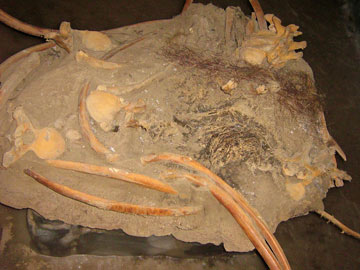|
NEWS NOTES
Mammoth DNA Proves Cause of Death?
mtDNA Print Exclusive
 Mammuthus lab Khatanga/Tom Gilbert |
| Scientists have recovered just 39 preserved woolly mammoth specimens from ice in the northern latitudes of North America and Siberia. Frozen hair samples are plentiful, however. |
The list of species that humans have driven to extinction is ever growing, but a new study on woolly mammoths might actually make that list one species shorter. Woolly mammoths roamed much of the Northern Hemisphere during the last ice age before going extinct toward the end of the Pleistocene 11,000 years ago. Scientists had long speculated that ice age hunters might be to blame, but a new comprehensive look at mammoth DNA may exonerate our ancestors as well as give researchers a better understanding of how some species go extinct today.
Genomicists Stephan C. Schuster and Webb Miller from the Penn State Center for Comparative Genomics and Bioinformatics in University Park, Pa., sequenced the mitochondrial genomes of five individual mammoths using DNA from clumps of frozen mammoth hair and combined their data with 13 other previously published mammoth genomes. They found that the samples were split into two distinct groups or subspecies — one group stayed in the middle of northern Siberia while the other had a much wider range, they reported June 9 in the Proceedings of the National Academy of Sciences. Furthermore, they say, the more confined species died out 45,000 years ago, thousands of years before humans are thought to have populated the northernmost latitudes.
“When the first group of mammoths died out, there was no human involvement,” Schuster says. “This proves mammoths could have died out on their own, without the help of human hunters.” Ruling out human hunting as a contributing factor in the first group leaves climate change, habitat loss and disease as the most probable causes of their extinction, he says.
Other mammoth researchers are not entirely convinced by this study, however. “This is really neat information, but I need to see more data,” says Larry Agenbroad, director of The Mammoth Site museum in Hot Springs, S.D. Schuster and Miller did not include any specimens from North America, Agenbroad notes, so their conclusions cannot speak to North American extinctions. “I have worked on three mammoth kill sites [in North America] and I know for a fact that humans hunted mammoths here,” he says. Whether other factors may have played a larger role, however, is unknown. Paleogeneticist Hendrik Poinar of McMaster University in Ontario, Canada, may have a better idea soon, though, as he and colleagues are currently working on sequencing 160 mammoth mitochondrial genomes, including some North American specimens.
Schuster’s study might also have implications beyond the Pleistocene extinction. He says scientists could use the mammoth data to study extinction patterns in some of today’s endangered species. The mammoths’ DNA revealed that neither group of mammoths was genetically well equipped. The specimens lacked genetic diversity, which Schuster says is important for ensuring that a population can adapt to new stresses or selection factors, like climate change.
In noting how the lack of diversity affected mammoths, Schuster says, “we find it striking to observe low genetic diversity in extinct populations and at the same time observe a similar situation with endangered species,” such as the Tasmanian devil. By studying genetic diversity in extinct animals like the mammoth, Schuster says that he hopes to map the genetic tipping point where populations become vulnerable, regardless of their numbers. “Species like the polar bear and right whale aren’t done in just by low numbers,” he says: “They can be doomed by a lack of genetic diversity too.”

 Subscribe
Subscribe


